2021-2022学年人教版七年级英语上册Unit 5 Do you have a soccer ball? 5课时教案
文档属性
| 名称 | 2021-2022学年人教版七年级英语上册Unit 5 Do you have a soccer ball? 5课时教案 | 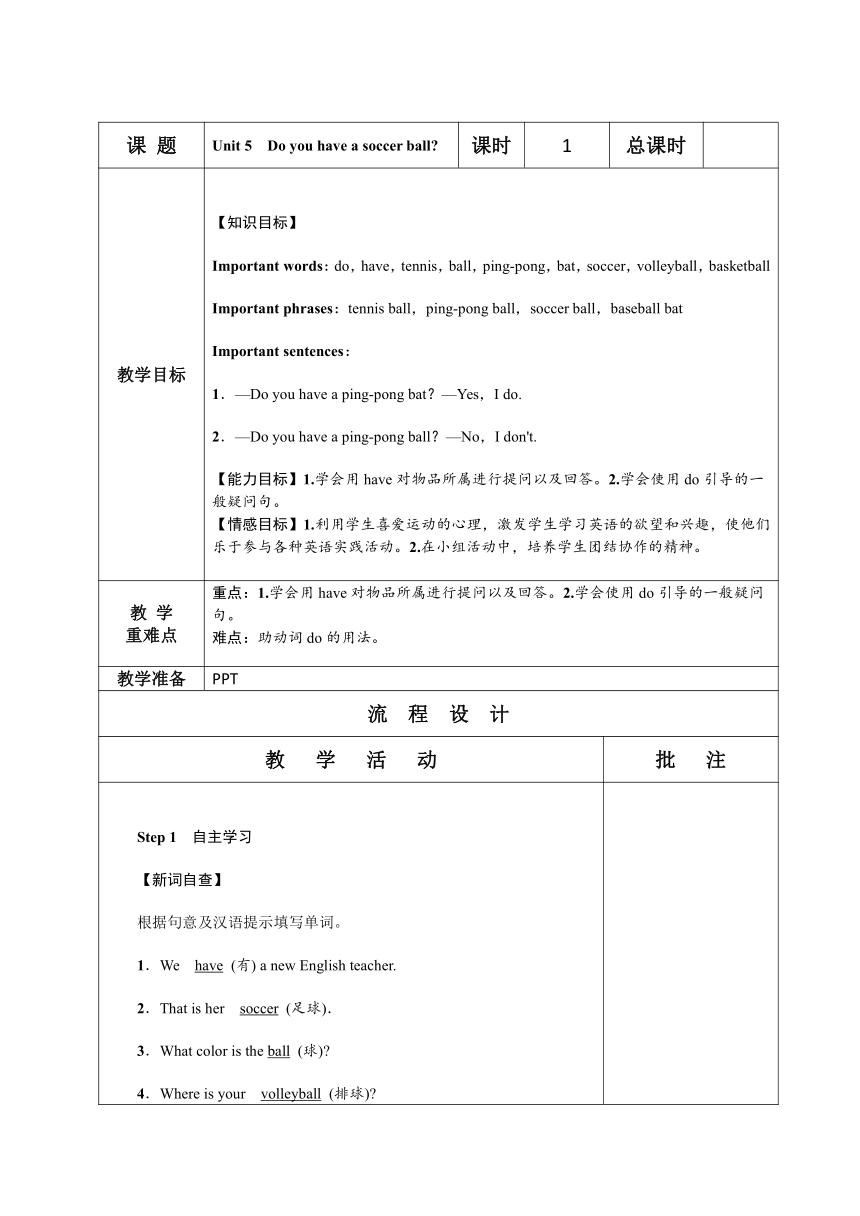 | |
| 格式 | zip | ||
| 文件大小 | 67.9KB | ||
| 资源类型 | 教案 | ||
| 版本资源 | 人教新目标(Go for it)版 | ||
| 科目 | 英语 | ||
| 更新时间 | 2021-07-06 08:20:49 | ||
图片预览

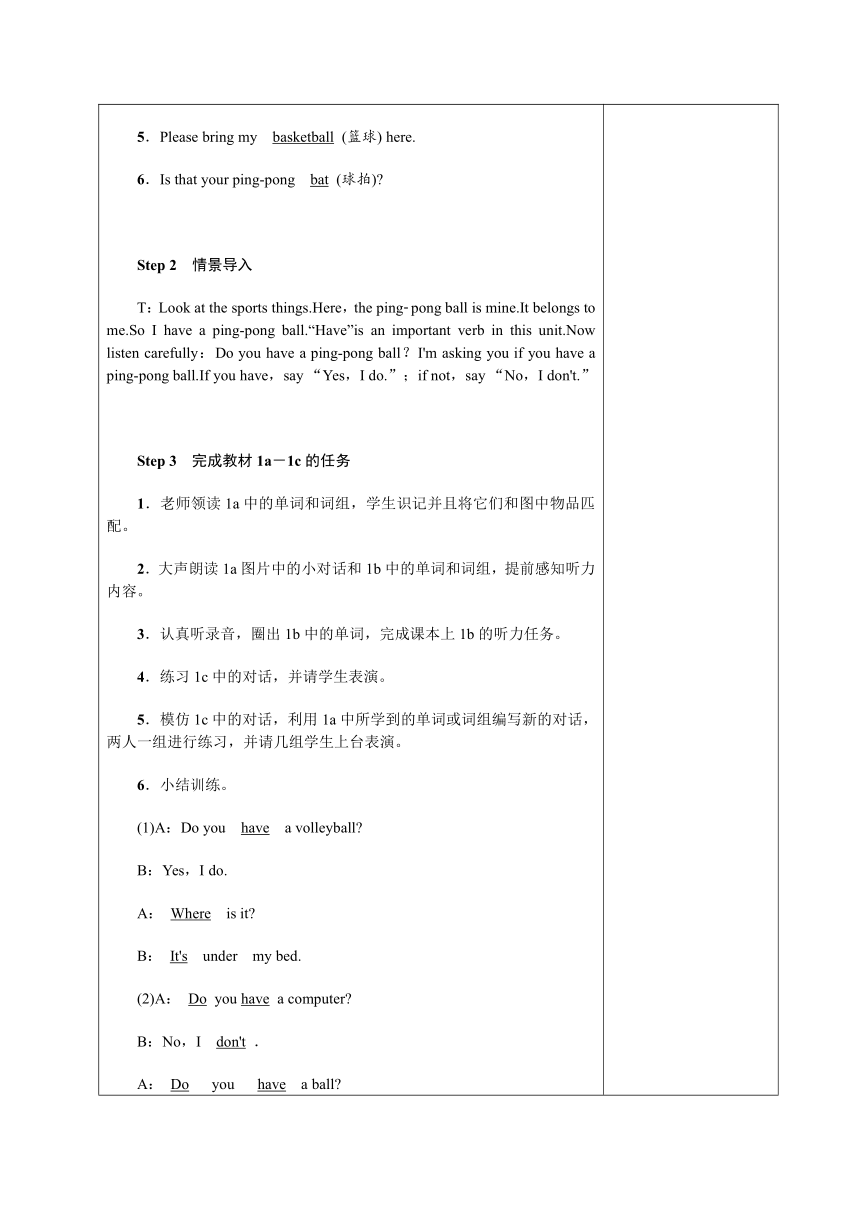
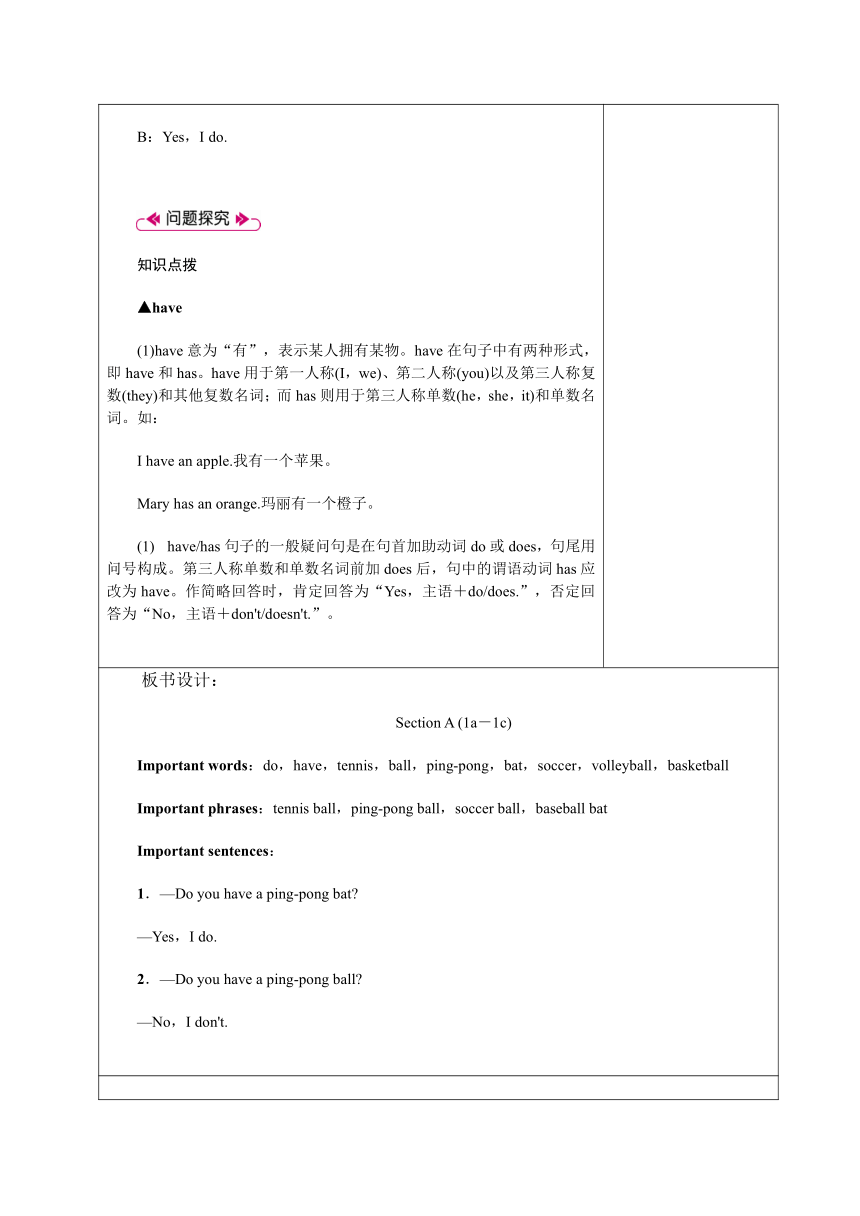
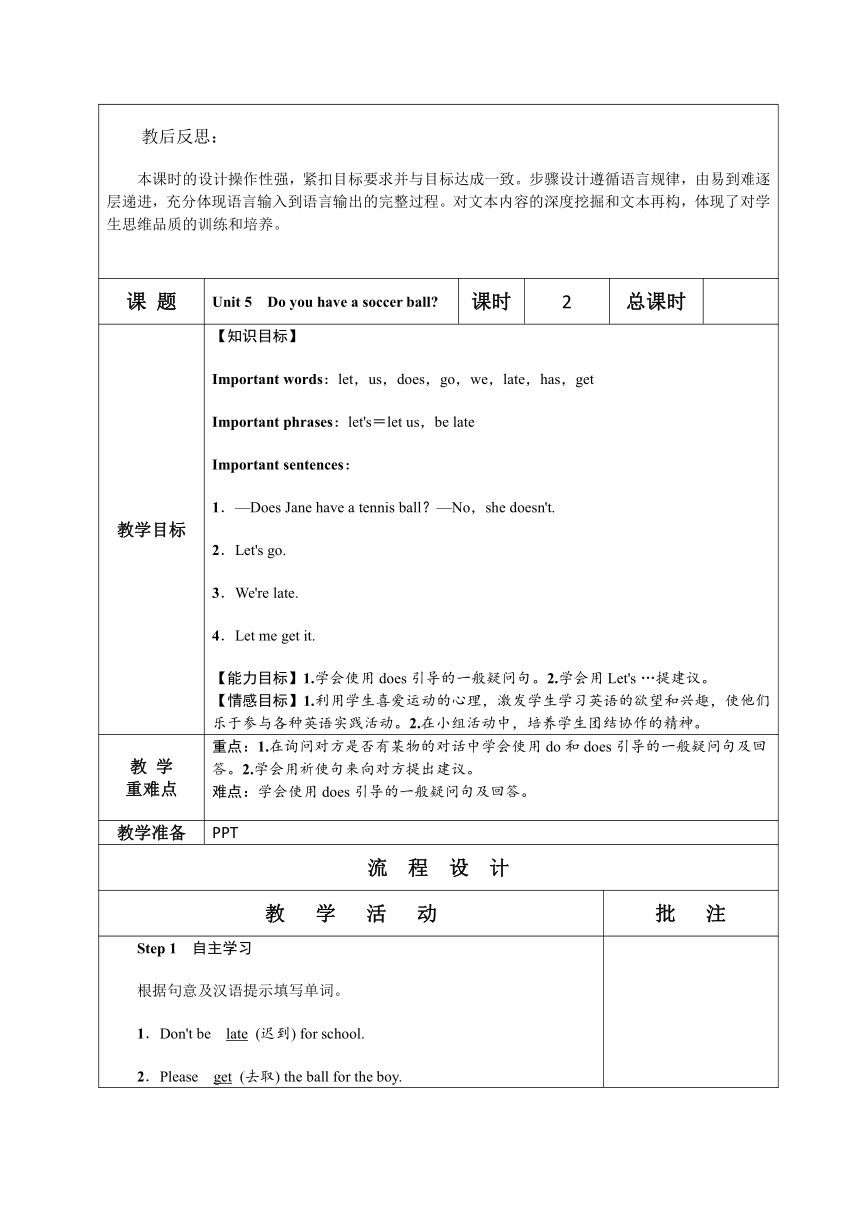
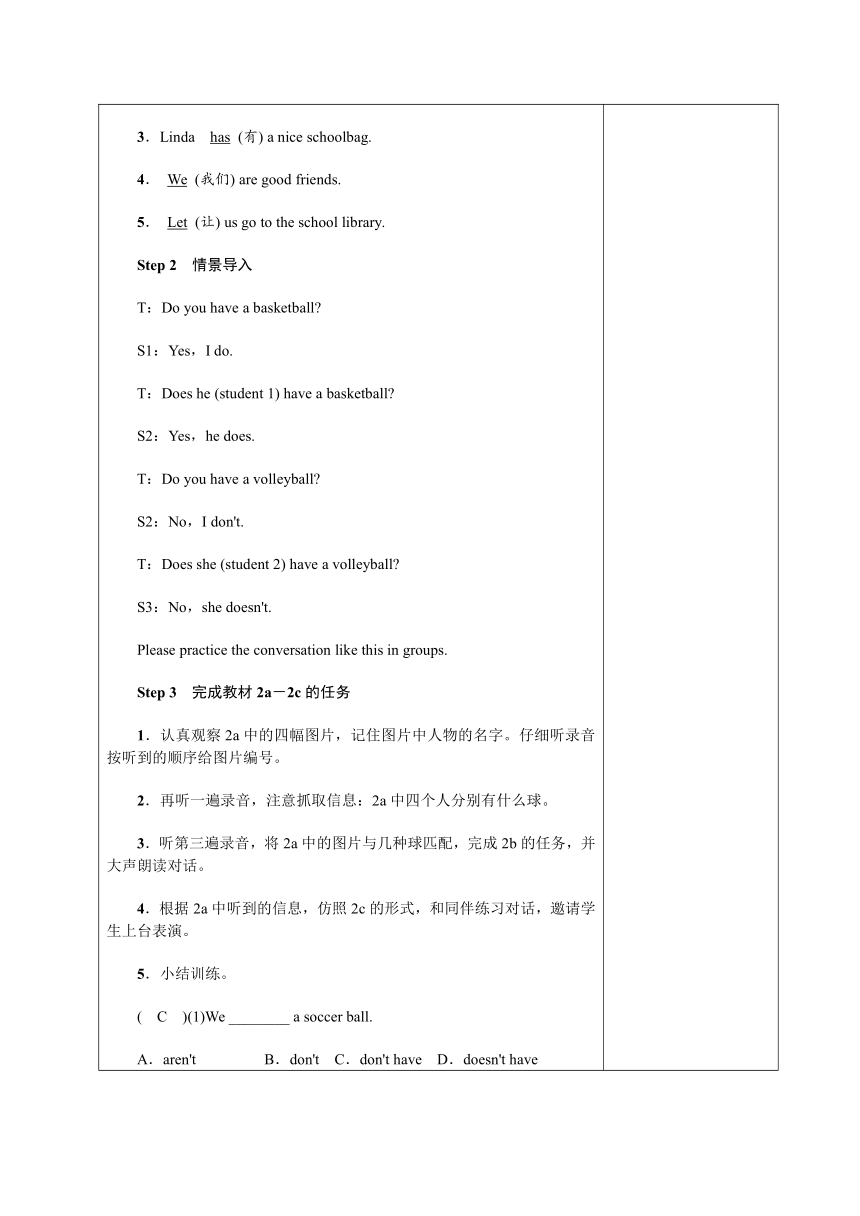
文档简介
课
题
Unit
5 Do
you
have
a
soccer
ball?
课时
1
总课时
教学目标
【知识目标】
Important
words:do,have,tennis,ball,ping?pong,bat,soccer,volleyball,basketball
Important
phrases:tennis
ball,ping?pong
ball,soccer
ball,baseball
bat
Important
sentences:
1.—Do
you
have
a
ping?pong
bat?—Yes,I
do.
2.—Do
you
have
a
ping?pong
ball?—No,I
don't.
【能力目标】1.学会用have对物品所属进行提问以及回答。2.学会使用do引导的一般疑问句。
【情感目标】1.利用学生喜爱运动的心理,激发学生学习英语的欲望和兴趣,使他们乐于参与各种英语实践活动。2.在小组活动中,培养学生团结协作的精神。
教
学
重难点
重点:1.学会用have对物品所属进行提问以及回答。2.学会使用do引导的一般疑问句。
难点:助动词do的用法。
教学准备
PPT
流
程
设
计
教
学
活
动
批
注
Step
1 自主学习
【新词自查】
根据句意及汉语提示填写单词。
1.We
have
(有)
a
new
English
teacher.
2.That
is
her
soccer
(足球).
3.What
color
is
the
ball
(球)?
4.Where
is
your
volleyball
(排球)?
5.Please
bring
my
basketball
(篮球)
here.
6.Is
that
your
ping?pong
bat
(球拍)?
Step
2 情景导入
T:Look
at
the
sports
things.Here,the
ping?pong
ball
is
mine.It
belongs
to
me.So
I
have
a
ping?pong
ball.“Have”is
an
important
verb
in
this
unit.Now
listen
carefully:Do
you
have
a
ping?pong
ball?I'm
asking
you
if
you
have
a
ping?pong
ball.If
you
have,say
“Yes,I
do.”;if
not,say
“No,I
don't.”
Step
3 完成教材1a-1c的任务
1.老师领读1a中的单词和词组,学生识记并且将它们和图中物品匹配。
2.大声朗读1a图片中的小对话和1b中的单词和词组,提前感知听力内容。
3.认真听录音,圈出1b中的单词,完成课本上1b的听力任务。
4.练习1c中的对话,并请学生表演。
5.模仿1c中的对话,利用1a中所学到的单词或词组编写新的对话,两人一组进行练习,并请几组学生上台表演。
6.小结训练。
(1)A:Do
you
have
a
volleyball?
B:Yes,I
do.
A:
Where
is
it?
B:
It's
under
my
bed.
(2)A:
Do
you
have
a
computer?
B:No,I
don't
.
A:
Do
you
have
a
ball?
B:Yes,I
do.
知识点拨
▲have
(1)have意为“有”,表示某人拥有某物。have在句子中有两种形式,即have和has。have用于第一人称(I,we)、第二人称(you)以及第三人称复数(they)和其他复数名词;而has则用于第三人称单数(he,she,it)和单数名词。如:
I
have
an
apple.我有一个苹果。
Mary
has
an
orange.玛丽有一个橙子。
have/has句子的一般疑问句是在句首加助动词do或does,句尾用问号构成。第三人称单数和单数名词前加does后,句中的谓语动词has应改为have。作简略回答时,肯定回答为“Yes,主语+do/does.”,否定回答为“No,主语+don't/doesn't.”。
板书设计:
Section
A
(1a-1c)
Important
words:do,have,tennis,ball,ping?pong,bat,soccer,volleyball,basketball
Important
phrases:tennis
ball,ping?pong
ball,soccer
ball,baseball
bat
Important
sentences:
1.—Do
you
have
a
ping?pong
bat?
—Yes,I
do.
2.—Do
you
have
a
ping?pong
ball?
—No,I
don't.
教后反思:
本课时的设计操作性强,紧扣目标要求并与目标达成一致。步骤设计遵循语言规律,由易到难逐层递进,充分体现语言输入到语言输出的完整过程。对文本内容的深度挖掘和文本再构,体现了对学生思维品质的训练和培养。
课
题
Unit
5 Do
you
have
a
soccer
ball?
课时
2
总课时
教学目标
【知识目标】
Important
words:let,us,does,go,we,late,has,get
Important
phrases:let's=let
us,be
late
Important
sentences:
1.—Does
Jane
have
a
tennis
ball?—No,she
doesn't.
2.Let's
go.
3.We're
late.
4.Let
me
get
it.
【能力目标】1.学会使用does引导的一般疑问句。2.学会用Let's
…提建议。
【情感目标】1.利用学生喜爱运动的心理,激发学生学习英语的欲望和兴趣,使他们乐于参与各种英语实践活动。2.在小组活动中,培养学生团结协作的精神。
教
学
重难点
重点:1.在询问对方是否有某物的对话中学会使用do和does引导的一般疑问句及回答。2.学会用祈使句来向对方提出建议。
难点:学会使用does引导的一般疑问句及回答。
教学准备
PPT
流
程
设
计
教
学
活
动
批
注
Step
1 自主学习
根据句意及汉语提示填写单词。
1.Don't
be
late
(迟到)
for
school.
2.Please
get
(去取)
the
ball
for
the
boy.
3.Linda
has
(有)
a
nice
schoolbag.
4.
We
(我们)
are
good
friends.
5.
Let
(让)
us
go
to
the
school
library.
Step
2 情景导入
T:Do
you
have
a
basketball?
S1:Yes,I
do.
T:Does
he
(student
1)
have
a
basketball?
S2:Yes,he
does.
T:Do
you
have
a
volleyball?
S2:No,I
don't.
T:Does
she
(student
2)
have
a
volleyball?
S3:No,she
doesn't.
Please
practice
the
conversation
like
this
in
groups.
Step
3 完成教材2a-2c的任务
1.认真观察2a中的四幅图片,记住图片中人物的名字。仔细听录音按听到的顺序给图片编号。
2.再听一遍录音,注意抓取信息:2a中四个人分别有什么球。
3.听第三遍录音,将2a中的图片与几种球匹配,完成2b的任务,并大声朗读对话。
4.根据2a中听到的信息,仿照2c的形式,和同伴练习对话,邀请学生上台表演。
5.小结训练。
( C )(1)We
________
a
soccer
ball.
A.aren't
B.don't
C.don't
have
D.doesn't
have
( A )(2)Jim,________
you
have
a
TV?
A.do B.is C.are D.does
( B )(3)—Does
your
brother
play
ping?pong?
—Yes,________.
A.he
is
B.he
does
C.he
doesn't
D.I
do
Step
4 完成教材2d的任务
1.学生自读对话,回答下面的问题:
(1)Does
Helen
have
the
baseball?
(2)Where
is
Helen's
baseball?
(3)Do
Helen
and
Cindy
have
the
baseball
bat?
2.大声朗读2d的对话,然后与同伴结对练习,分角色表演对话。
3.邀请三组学生来表演对话。
4.小结训练。
( B )(1)I
have
________
basketball.It's
in
________
bag.
A.a;me B.a;my C./;me D./;my
( A )(2)It's
seven
o'clock.She
________
late.
A.is
B.does
C.do
D.are
( C )(3)Do
they
________
English
books?
A.is
B.are
C.have
D.do
( D )(4)Let's
________
sports
after
class.
A.to
play
B.Plays
C.playing
D.play
知识点拨
▲let
以动词let开头的祈使句,表示向别人提建议。基本结构为:let
sb.do
sth.,表示
“让某人做某事”。其中sb.可由名词或代词宾格来充当,其后的动词一定要用动词原形。
▲辨析we,us与our
(1)we
“我们”,是人称代词主格形式,作句子的主语。
(2)us
“我们”,是人称代词宾格形式,放在介词或动词后作宾语。
(3)our
“我们的”,是形容词性物主代词,放在名词前作定语。
板书设计:
Section
A
(2a-2d)
Important
words:let,us,does,go,we,late,has,get
Important
phrases:let's=let
us,be
late
Important
sentences:
1.—Does
Jane
have
a
tennis
ball?—No,she
doesn't.
2.Let's
go.
3.We
are
late.
4.Let
me
get
it.
教后反思:本课时设计清晰,紧扣目标要求并与目标达成一致。步骤设计遵循语言规律,由易到难逐层递进,充分体现语言输入到语言输出的完整过程。对文本内容的深度挖掘和文本再构,体现了对学生思维品质的训练和培养。
课
题
Unit
5 Do
you
have
a
soccer
ball?
课时
3
总课时
教学目标
【知识目标】
Important
words:great,play,sound
Important
phrases:don't=do
not,doesn't=does
not
Important
sentences:
1.Does
John
have
a
soccer
ball,too?
2.I
think
he
has
a
ping?pong
ball.
3.That
sounds
good.
【能力目标】1.进一步学习通过运用have对物品所属关系进行提问以及回答。2.继续学习do和does引导的一般疑问句,理解并掌握英语句子中的人称和数,掌握并熟练运用此类句型。3.能用Let's…句型来提建议。
【情感目标】1.利用学生喜爱运动的心理,激发学生学习英语的欲望和兴趣,使他们乐于参与各种英语实践活动。2.在小组活动中,培养学生团结协作的精神。
教
学
重难点
重点:1.总结do和does引导的一般疑问句及其应答语。2.在实际生活情景中能正确运用所学的句型谈论自己或他人所拥有的东西。3.理解并掌握英语句子中的人称与数,让学生牢记第三人称单数。
难点:1.在实际生活情景中能正确运用Do/Does…?句型谈论自己或他人所拥有的东西。2.理解并掌握英语句子中的人称与数,让学生牢记第三人称单数。
教学准备
PPT
流
程
设
计
教
学
活
动
批
注
Step
1 自主学习
【语法自测】
按要求完成句子,每空一词。
1.Lily
has
a
white
schoolbag.(改为一般疑问句)
Does
Lily
have
a
white
schoolbag?
2.I
have
some__photos.(对画线部分提问)
What
do
you
have?
3.Does
he
have
a
sister?(作否定回答)
No
,
he
doesn't
.
4.We
have
some
new
books.(用she替换we改写句子)
She
has
some
new
books.
5.They
have
an
English
friend.(改为否定句)
They
don't
have
an
English
friend.
Step
2 情景导入
T:Do
you
have
a
basketball?
S:No,I
don't.
T:Oh,what
a
pity!You
don't
have
a
basketball.Do
you
have
a
volleyball?
S:Yes,I
do.
T:Nice.Let's
play
volleyball.
S:That
sounds
good.
Step
3 畅通Grammar
Focus回顾语法重点
Read
Grammar
Focus
and
practice
these
sentences.
Step
4 完成教材3a-3b的任务
1.学生将3a方框中的单词填入表格中正确的位置。
2.学生用表格中的单词造句,比一比,看谁写得又快又对。
3.学生用do或does填写3b中的空白补全对话,然后结伴练习对话,邀请几个小组展示。
Step
5 完成教材3c的任务
学生记住鲍勃房间里的物品,然后合上书模仿3c中的对话,与同伴问答,然后结对练习。
知识点拨
▲英语中的人称和数
人称汉语主格助动词宾格单数第一人称我Idome第二人称你youyou第三人称他hedoeshim她sheher它itit复数第一人称我们wedous第二人称你们youyou第三人称他/她/它们theythem
▲实义动词的一般疑问句结构
(1)当主语是第一人称/第二人称/第三人称复数/复数名词时,句型结构为:Do+主语+动词原形+其他?
肯定回答:Yes,I/they
/we…
do.否定回答:No,I
/they/we…
don't.
(2)当主语是第三人称单数/单数名词时(she,he,it,Linda,Bob,an
apple…),句型结构为:Does+主语+动词原形+其他?
肯定回答:Yes,she/he/it…
does.
否定回答:No,she/he/it…
doesn't.
▲play+球类
play作动词,意为“玩;打”,后接球类名词时不加冠词。如:play
basketball,play
ping?pong
▲That
sounds
good.那听起来不错。
sound连系动词,意思是“听起来”,后跟形容词。
板书设计:
Section
A
(Grammar
Focus-3c)
Important
sentences:
1.Does
John
have
a
soccer
ball,too?
2.I
think
he
has
a
ping?pong
ball.
3.That
sounds
good.
教后反思:
本节课我从不同的角度带领学生畅通Grammar
Focus:朗读、讨论、问答、对话展示等,不仅锻炼了学生的语言综合运用能力,而且巩固了学生对目标语言的学习、识记和运用。本课时的设计操作性强,紧扣目标要求并与目标达成一致;注重教学内容和学生的生活经验相结合,实现了学以致用的教学目标。
课
题
Unit
5 Do
you
have
a
soccer
ball?
课时
4
总课时
教学目标
【知识目标】
Important
words:interesting,boring,fun,difficult,relaxing,watch
Important
phrases:watch
TV,play
computer
games,play
volleyball/basketball
Important
sentences:
1.Let's
play
computer
games.
2.That
sounds
interesting.
【能力目标】1.掌握重点词汇。2.用Let's…句型提建议。3.能用所学的形容词来表达自己对某项运动项目的看法。
【情感目标】通过练习有关运动的对话,使学生更加热爱体育活动并培养适合自己的体育爱好。
教
学
重难点
重点:1.学会用Let's…
提建议,并能够谈论自己对某项球类运动的简单看法。2.引导学生进行听力和口语交际训练,逐步学会用Let's…
提建议。
难点:一般现在时的肯定句、否定句的结构,尤其是单三形式的变化。
教学准备
PPT
流
程
设
计
教
学
活
动
批
注
Step
1 自主学习
【新词自查】
根据句意及首字母提示填写单词。
1.It's
fun
to
play
games
with
friends.
2.I
can
watch
TV
on
Sunday.
3.I
don't
like
football.It's
too
boring
.
4.I
think
math
is
difficult
.
5.The
storybook
is
so
interesting
.
6.Playing
sports
is
relaxing
.
Step
2 情景导入
Review
the
expressions
and
sentence
structures
we
have
learned.
Step
3 完成教材1a-1d的任务
Pre?listening
1.(Show
the
picture
in
which
a
boy
is
doing
an
interesting
thing
on
the
screen.)Learn
the
new
word:interesting.
(Show
other
pictures
on
the
screen.)Learn
the
new
words:boring,fun,difficult,relaxing,easy
in
the
same
way.
2.(Show
some
activity
pictures
on
the
screen.)Learn
the
new
phrases:watch
TV,play
volleyball,play
basketball,play
computer
games.
3.Let
students
read
the
new
words
and
phrases
and
try
to
remember
them.
4.Read
the
words
in
1a.(Point
to
the
five
words
in
1a
and
ask
students
to
repeat
each
one.)
While?listening
1.T:Now
we'll
listen
to
a
conversation.Here
are
two
persons
in
the
conversation.What
do
they
want
to
do?Listen
carefully.
(Play
the
recording
for
the
first
time.Students
only
listen.)
2.T:Listen
again
and
check
the
words
you
hear
in
1a.(Play
the
recording
again.)
3.Check
the
answers.
4.T:Listen
to
the
recording
in
1b
again.What
does
Paul
say
about
the
activities?Choose
a
word
from
1a
to
fill
in
each
blank
in
1c.(Play
the
recording
again.)
Post?listening
1.T:Act
out
the
conversation
in
1d
in
pairs.You
are
Paul.Your
partner
Jenny
is
Paul's
friend.Talk
about
the
activities
in
1c.
S1:Let's
play
computer
games.
S2:That
sounds
interesting
but…
(Let
some
pairs
act
out
the
conversations
in
front
of
the
class.)
知识点拨
▲let's=let
us
let
sb.
do
sth.意为“让某人做某事”。
▲watch
watch作动词,意为“观看”。watch也可作名词,意为“手表”。
▲Let's
play
computer
games.让我们玩电脑游戏吧。
let为使役动词,后面接动词原形。其肯定答语为:That
sounds
good/interesting/boring…否定答语为:I
am
sorry,I…
板书设计:
Section
B
(1a-1d)
Important
words:interesting,boring,fun,difficult,relaxing,watch
Important
phrases:watch
TV,play
computer
games,play
volleyball/basketball
Important
sentences:
1.Let's
play
computer
games.
2.That
sounds
interesting.
教后反思:
本节课通过听力训练,学生能听懂目标词汇与基本句型,能用目标词汇回答问题,能够运用本课句型,通过反复朗诵课文,用目标词汇和语言进行对话。
课
题
Unit
5 Do
you
have
a
soccer
ball?
课时
5
总课时
教学目标
【知识目标】
Important
words:same,love,with,sport,them,only,like,easy,after,class,classmate
Important
phrases:after
class,in
the
same
school
Important
sentences:
1.I
don't
have
a
soccer
ball,but
my
brother
Alan
does.
2.I
love
sports,but
I
don't
play
them—I
only
watch
them
on
TV!
3.After
class,I
play
ping?pong
with
my
classmates.
【能力目标】阅读有关体育用品收藏的小短文,并能获得相关信息。
【情感目标】通过阅读有关运动的文章和对话,使学生更加热爱体育活动并培养一种适合自己的体育爱好。
教
学
重难点
重点:1.能够谈论自己对某球类运动的简单看法。2.引导学生进行阅读训练,掌握行为动词一般现在时的肯定句、否定句的结构,尤其是单三形式的变化。
难点:行为动词一般现在时的肯定句、否定句的结构,尤其是单三形式的变化。
教学准备
PPT
流
程
设
计
教
学
活
动
批
注
Step
1 自主学习
【新词自查】
根据句意及汉语提示填写单词。
1.That
sounds
easy
(容易的).
2.I
love
(喜爱)
sports.
3.I
only
(只)
have
one
friend
in
this
class.
4.We
have
the
same
(相同的)
English
teacher,Mr.Lee.
5.Do
you
like
(喜欢)
playing
computer
games?
6.They're
my
brother's
classmates
(同班同学).
7.She
is
always
late
for
class
(课).
Step
2 情景导入
T:Hi,everyone.Do
you
have
a
basketball?
Ss:Yes,I
do./No,I
don't.
T:I
have
a
great
sports
collection.Do
you
want
to
know
about
it?Then
let
me
tell
you
something
in
this
lesson.
Step
3 完成教材2a-2c的任务
Read
for
the
contents
1.T:Our
school
magazine
made
a
survey
about
sports
collection.Here
are
the
survey
results.Read
the
passage
and
answer
the
question:Who
has
a
soccer
ball?
2.Students
read
the
passage
quickly
and
find
the
answer
to
the
question.
3.Check
the
answers.Let
some
students
say
their
answers
and
say
why.
(指导:在读短文时,应重点抓住soccer
ball,通过对比文中的信息,从而轻松地知道答案。)
Read
for
the
details
1.T:Now
let's
work
on
2c.Who
do
you
think
says
these
sentences?Check
(√)F
for
Frank,G
for
Gina
or
W
for
Wang
Wei.
Read
the
passage
carefully
and
check
the
right
person.
2.Students
read
the
passage
carefully
and
discuss
with
their
partners.
(指导:先读懂2c中每句话的意思,然后在短文中寻找和题目中句子意思相同或相近的句子,比如not
easy意为difficult。
最后,再看这是对谁的调查,便能确认正确的人物。)
3.Check
the
answers
with
the
class.
Step
4 完成教材3a-3c的任务
1.学生自主写出几个询问体育用品收藏的问题。
2.在小组内交流3a的问题并做调查,让对方回答问题。
3.学生根据3a的信息写一段话,谈谈自己和同伴,尝试在句中使用but。并且请一些学生读出自己的一段对话。
I
don't
have
a
baseball,but
I
have
a
ping?pong
ball.My
father
has
a
tennis
bat,but
my
uncle
has
a
baseball
bat.
Step
5 完成教材Self
Check的任务
1.写出你知道的运动名称,并在每项运动的后面写出形容词来表明你的看法,完成1部分的任务。写完后小组交流并大声朗读。
2.认真阅读2部分的对话,补全问句或答语,集体核对答案。
3.两人一组练习对话,并邀请几组学生来表演对话。
知识点拨
▲love
动词,意为“喜欢;喜爱”,比
like
的程度深。常见的结构为:love+sth./
sb.意为“喜爱某物/某人”。如:
Love
me,love
my
dog.
爱屋及乌。
▲I
only
watch
them
on
TV!我只在电视上看它们。
watch…on
TV
表示“在电视上看……
(节目)”,其中watch是动词,意为“观看;
注视”,强调观看其行为动作,跟踪其运动目标,有“监视”之意,侧重于场面、过程。
on
TV是固定短语,意为“在电视上”。
板书设计:
Section
B
(2a-3c)&
Self
Check
Important
words:same,love,with,sport,them,only,like,easy,after,class,classmate
Important
phrases:after
class,in
the
same
school
Important
sentences:
1.I
don't
have
a
soccer
ball,but
my
brother
Alan
does.
2.I
love
sports,but
I
don't
play
them—I
only
watch
them
on
TV!
3.After
class,I
play
ping?pong
with
my
classmates.
教后反思:
本节课在阅读教学过程中体现了阅读兴趣的培养和阅读技巧的指导。此外,不同形式的写作训练,由易到难,培养了学生的写作能力。
题
Unit
5 Do
you
have
a
soccer
ball?
课时
1
总课时
教学目标
【知识目标】
Important
words:do,have,tennis,ball,ping?pong,bat,soccer,volleyball,basketball
Important
phrases:tennis
ball,ping?pong
ball,soccer
ball,baseball
bat
Important
sentences:
1.—Do
you
have
a
ping?pong
bat?—Yes,I
do.
2.—Do
you
have
a
ping?pong
ball?—No,I
don't.
【能力目标】1.学会用have对物品所属进行提问以及回答。2.学会使用do引导的一般疑问句。
【情感目标】1.利用学生喜爱运动的心理,激发学生学习英语的欲望和兴趣,使他们乐于参与各种英语实践活动。2.在小组活动中,培养学生团结协作的精神。
教
学
重难点
重点:1.学会用have对物品所属进行提问以及回答。2.学会使用do引导的一般疑问句。
难点:助动词do的用法。
教学准备
PPT
流
程
设
计
教
学
活
动
批
注
Step
1 自主学习
【新词自查】
根据句意及汉语提示填写单词。
1.We
have
(有)
a
new
English
teacher.
2.That
is
her
soccer
(足球).
3.What
color
is
the
ball
(球)?
4.Where
is
your
volleyball
(排球)?
5.Please
bring
my
basketball
(篮球)
here.
6.Is
that
your
ping?pong
bat
(球拍)?
Step
2 情景导入
T:Look
at
the
sports
things.Here,the
ping?pong
ball
is
mine.It
belongs
to
me.So
I
have
a
ping?pong
ball.“Have”is
an
important
verb
in
this
unit.Now
listen
carefully:Do
you
have
a
ping?pong
ball?I'm
asking
you
if
you
have
a
ping?pong
ball.If
you
have,say
“Yes,I
do.”;if
not,say
“No,I
don't.”
Step
3 完成教材1a-1c的任务
1.老师领读1a中的单词和词组,学生识记并且将它们和图中物品匹配。
2.大声朗读1a图片中的小对话和1b中的单词和词组,提前感知听力内容。
3.认真听录音,圈出1b中的单词,完成课本上1b的听力任务。
4.练习1c中的对话,并请学生表演。
5.模仿1c中的对话,利用1a中所学到的单词或词组编写新的对话,两人一组进行练习,并请几组学生上台表演。
6.小结训练。
(1)A:Do
you
have
a
volleyball?
B:Yes,I
do.
A:
Where
is
it?
B:
It's
under
my
bed.
(2)A:
Do
you
have
a
computer?
B:No,I
don't
.
A:
Do
you
have
a
ball?
B:Yes,I
do.
知识点拨
▲have
(1)have意为“有”,表示某人拥有某物。have在句子中有两种形式,即have和has。have用于第一人称(I,we)、第二人称(you)以及第三人称复数(they)和其他复数名词;而has则用于第三人称单数(he,she,it)和单数名词。如:
I
have
an
apple.我有一个苹果。
Mary
has
an
orange.玛丽有一个橙子。
have/has句子的一般疑问句是在句首加助动词do或does,句尾用问号构成。第三人称单数和单数名词前加does后,句中的谓语动词has应改为have。作简略回答时,肯定回答为“Yes,主语+do/does.”,否定回答为“No,主语+don't/doesn't.”。
板书设计:
Section
A
(1a-1c)
Important
words:do,have,tennis,ball,ping?pong,bat,soccer,volleyball,basketball
Important
phrases:tennis
ball,ping?pong
ball,soccer
ball,baseball
bat
Important
sentences:
1.—Do
you
have
a
ping?pong
bat?
—Yes,I
do.
2.—Do
you
have
a
ping?pong
ball?
—No,I
don't.
教后反思:
本课时的设计操作性强,紧扣目标要求并与目标达成一致。步骤设计遵循语言规律,由易到难逐层递进,充分体现语言输入到语言输出的完整过程。对文本内容的深度挖掘和文本再构,体现了对学生思维品质的训练和培养。
课
题
Unit
5 Do
you
have
a
soccer
ball?
课时
2
总课时
教学目标
【知识目标】
Important
words:let,us,does,go,we,late,has,get
Important
phrases:let's=let
us,be
late
Important
sentences:
1.—Does
Jane
have
a
tennis
ball?—No,she
doesn't.
2.Let's
go.
3.We're
late.
4.Let
me
get
it.
【能力目标】1.学会使用does引导的一般疑问句。2.学会用Let's
…提建议。
【情感目标】1.利用学生喜爱运动的心理,激发学生学习英语的欲望和兴趣,使他们乐于参与各种英语实践活动。2.在小组活动中,培养学生团结协作的精神。
教
学
重难点
重点:1.在询问对方是否有某物的对话中学会使用do和does引导的一般疑问句及回答。2.学会用祈使句来向对方提出建议。
难点:学会使用does引导的一般疑问句及回答。
教学准备
PPT
流
程
设
计
教
学
活
动
批
注
Step
1 自主学习
根据句意及汉语提示填写单词。
1.Don't
be
late
(迟到)
for
school.
2.Please
get
(去取)
the
ball
for
the
boy.
3.Linda
has
(有)
a
nice
schoolbag.
4.
We
(我们)
are
good
friends.
5.
Let
(让)
us
go
to
the
school
library.
Step
2 情景导入
T:Do
you
have
a
basketball?
S1:Yes,I
do.
T:Does
he
(student
1)
have
a
basketball?
S2:Yes,he
does.
T:Do
you
have
a
volleyball?
S2:No,I
don't.
T:Does
she
(student
2)
have
a
volleyball?
S3:No,she
doesn't.
Please
practice
the
conversation
like
this
in
groups.
Step
3 完成教材2a-2c的任务
1.认真观察2a中的四幅图片,记住图片中人物的名字。仔细听录音按听到的顺序给图片编号。
2.再听一遍录音,注意抓取信息:2a中四个人分别有什么球。
3.听第三遍录音,将2a中的图片与几种球匹配,完成2b的任务,并大声朗读对话。
4.根据2a中听到的信息,仿照2c的形式,和同伴练习对话,邀请学生上台表演。
5.小结训练。
( C )(1)We
________
a
soccer
ball.
A.aren't
B.don't
C.don't
have
D.doesn't
have
( A )(2)Jim,________
you
have
a
TV?
A.do B.is C.are D.does
( B )(3)—Does
your
brother
play
ping?pong?
—Yes,________.
A.he
is
B.he
does
C.he
doesn't
D.I
do
Step
4 完成教材2d的任务
1.学生自读对话,回答下面的问题:
(1)Does
Helen
have
the
baseball?
(2)Where
is
Helen's
baseball?
(3)Do
Helen
and
Cindy
have
the
baseball
bat?
2.大声朗读2d的对话,然后与同伴结对练习,分角色表演对话。
3.邀请三组学生来表演对话。
4.小结训练。
( B )(1)I
have
________
basketball.It's
in
________
bag.
A.a;me B.a;my C./;me D./;my
( A )(2)It's
seven
o'clock.She
________
late.
A.is
B.does
C.do
D.are
( C )(3)Do
they
________
English
books?
A.is
B.are
C.have
D.do
( D )(4)Let's
________
sports
after
class.
A.to
play
B.Plays
C.playing
D.play
知识点拨
▲let
以动词let开头的祈使句,表示向别人提建议。基本结构为:let
sb.do
sth.,表示
“让某人做某事”。其中sb.可由名词或代词宾格来充当,其后的动词一定要用动词原形。
▲辨析we,us与our
(1)we
“我们”,是人称代词主格形式,作句子的主语。
(2)us
“我们”,是人称代词宾格形式,放在介词或动词后作宾语。
(3)our
“我们的”,是形容词性物主代词,放在名词前作定语。
板书设计:
Section
A
(2a-2d)
Important
words:let,us,does,go,we,late,has,get
Important
phrases:let's=let
us,be
late
Important
sentences:
1.—Does
Jane
have
a
tennis
ball?—No,she
doesn't.
2.Let's
go.
3.We
are
late.
4.Let
me
get
it.
教后反思:本课时设计清晰,紧扣目标要求并与目标达成一致。步骤设计遵循语言规律,由易到难逐层递进,充分体现语言输入到语言输出的完整过程。对文本内容的深度挖掘和文本再构,体现了对学生思维品质的训练和培养。
课
题
Unit
5 Do
you
have
a
soccer
ball?
课时
3
总课时
教学目标
【知识目标】
Important
words:great,play,sound
Important
phrases:don't=do
not,doesn't=does
not
Important
sentences:
1.Does
John
have
a
soccer
ball,too?
2.I
think
he
has
a
ping?pong
ball.
3.That
sounds
good.
【能力目标】1.进一步学习通过运用have对物品所属关系进行提问以及回答。2.继续学习do和does引导的一般疑问句,理解并掌握英语句子中的人称和数,掌握并熟练运用此类句型。3.能用Let's…句型来提建议。
【情感目标】1.利用学生喜爱运动的心理,激发学生学习英语的欲望和兴趣,使他们乐于参与各种英语实践活动。2.在小组活动中,培养学生团结协作的精神。
教
学
重难点
重点:1.总结do和does引导的一般疑问句及其应答语。2.在实际生活情景中能正确运用所学的句型谈论自己或他人所拥有的东西。3.理解并掌握英语句子中的人称与数,让学生牢记第三人称单数。
难点:1.在实际生活情景中能正确运用Do/Does…?句型谈论自己或他人所拥有的东西。2.理解并掌握英语句子中的人称与数,让学生牢记第三人称单数。
教学准备
PPT
流
程
设
计
教
学
活
动
批
注
Step
1 自主学习
【语法自测】
按要求完成句子,每空一词。
1.Lily
has
a
white
schoolbag.(改为一般疑问句)
Does
Lily
have
a
white
schoolbag?
2.I
have
some__photos.(对画线部分提问)
What
do
you
have?
3.Does
he
have
a
sister?(作否定回答)
No
,
he
doesn't
.
4.We
have
some
new
books.(用she替换we改写句子)
She
has
some
new
books.
5.They
have
an
English
friend.(改为否定句)
They
don't
have
an
English
friend.
Step
2 情景导入
T:Do
you
have
a
basketball?
S:No,I
don't.
T:Oh,what
a
pity!You
don't
have
a
basketball.Do
you
have
a
volleyball?
S:Yes,I
do.
T:Nice.Let's
play
volleyball.
S:That
sounds
good.
Step
3 畅通Grammar
Focus回顾语法重点
Read
Grammar
Focus
and
practice
these
sentences.
Step
4 完成教材3a-3b的任务
1.学生将3a方框中的单词填入表格中正确的位置。
2.学生用表格中的单词造句,比一比,看谁写得又快又对。
3.学生用do或does填写3b中的空白补全对话,然后结伴练习对话,邀请几个小组展示。
Step
5 完成教材3c的任务
学生记住鲍勃房间里的物品,然后合上书模仿3c中的对话,与同伴问答,然后结对练习。
知识点拨
▲英语中的人称和数
人称汉语主格助动词宾格单数第一人称我Idome第二人称你youyou第三人称他hedoeshim她sheher它itit复数第一人称我们wedous第二人称你们youyou第三人称他/她/它们theythem
▲实义动词的一般疑问句结构
(1)当主语是第一人称/第二人称/第三人称复数/复数名词时,句型结构为:Do+主语+动词原形+其他?
肯定回答:Yes,I/they
/we…
do.否定回答:No,I
/they/we…
don't.
(2)当主语是第三人称单数/单数名词时(she,he,it,Linda,Bob,an
apple…),句型结构为:Does+主语+动词原形+其他?
肯定回答:Yes,she/he/it…
does.
否定回答:No,she/he/it…
doesn't.
▲play+球类
play作动词,意为“玩;打”,后接球类名词时不加冠词。如:play
basketball,play
ping?pong
▲That
sounds
good.那听起来不错。
sound连系动词,意思是“听起来”,后跟形容词。
板书设计:
Section
A
(Grammar
Focus-3c)
Important
sentences:
1.Does
John
have
a
soccer
ball,too?
2.I
think
he
has
a
ping?pong
ball.
3.That
sounds
good.
教后反思:
本节课我从不同的角度带领学生畅通Grammar
Focus:朗读、讨论、问答、对话展示等,不仅锻炼了学生的语言综合运用能力,而且巩固了学生对目标语言的学习、识记和运用。本课时的设计操作性强,紧扣目标要求并与目标达成一致;注重教学内容和学生的生活经验相结合,实现了学以致用的教学目标。
课
题
Unit
5 Do
you
have
a
soccer
ball?
课时
4
总课时
教学目标
【知识目标】
Important
words:interesting,boring,fun,difficult,relaxing,watch
Important
phrases:watch
TV,play
computer
games,play
volleyball/basketball
Important
sentences:
1.Let's
play
computer
games.
2.That
sounds
interesting.
【能力目标】1.掌握重点词汇。2.用Let's…句型提建议。3.能用所学的形容词来表达自己对某项运动项目的看法。
【情感目标】通过练习有关运动的对话,使学生更加热爱体育活动并培养适合自己的体育爱好。
教
学
重难点
重点:1.学会用Let's…
提建议,并能够谈论自己对某项球类运动的简单看法。2.引导学生进行听力和口语交际训练,逐步学会用Let's…
提建议。
难点:一般现在时的肯定句、否定句的结构,尤其是单三形式的变化。
教学准备
PPT
流
程
设
计
教
学
活
动
批
注
Step
1 自主学习
【新词自查】
根据句意及首字母提示填写单词。
1.It's
fun
to
play
games
with
friends.
2.I
can
watch
TV
on
Sunday.
3.I
don't
like
football.It's
too
boring
.
4.I
think
math
is
difficult
.
5.The
storybook
is
so
interesting
.
6.Playing
sports
is
relaxing
.
Step
2 情景导入
Review
the
expressions
and
sentence
structures
we
have
learned.
Step
3 完成教材1a-1d的任务
Pre?listening
1.(Show
the
picture
in
which
a
boy
is
doing
an
interesting
thing
on
the
screen.)Learn
the
new
word:interesting.
(Show
other
pictures
on
the
screen.)Learn
the
new
words:boring,fun,difficult,relaxing,easy
in
the
same
way.
2.(Show
some
activity
pictures
on
the
screen.)Learn
the
new
phrases:watch
TV,play
volleyball,play
basketball,play
computer
games.
3.Let
students
read
the
new
words
and
phrases
and
try
to
remember
them.
4.Read
the
words
in
1a.(Point
to
the
five
words
in
1a
and
ask
students
to
repeat
each
one.)
While?listening
1.T:Now
we'll
listen
to
a
conversation.Here
are
two
persons
in
the
conversation.What
do
they
want
to
do?Listen
carefully.
(Play
the
recording
for
the
first
time.Students
only
listen.)
2.T:Listen
again
and
check
the
words
you
hear
in
1a.(Play
the
recording
again.)
3.Check
the
answers.
4.T:Listen
to
the
recording
in
1b
again.What
does
Paul
say
about
the
activities?Choose
a
word
from
1a
to
fill
in
each
blank
in
1c.(Play
the
recording
again.)
Post?listening
1.T:Act
out
the
conversation
in
1d
in
pairs.You
are
Paul.Your
partner
Jenny
is
Paul's
friend.Talk
about
the
activities
in
1c.
S1:Let's
play
computer
games.
S2:That
sounds
interesting
but…
(Let
some
pairs
act
out
the
conversations
in
front
of
the
class.)
知识点拨
▲let's=let
us
let
sb.
do
sth.意为“让某人做某事”。
▲watch
watch作动词,意为“观看”。watch也可作名词,意为“手表”。
▲Let's
play
computer
games.让我们玩电脑游戏吧。
let为使役动词,后面接动词原形。其肯定答语为:That
sounds
good/interesting/boring…否定答语为:I
am
sorry,I…
板书设计:
Section
B
(1a-1d)
Important
words:interesting,boring,fun,difficult,relaxing,watch
Important
phrases:watch
TV,play
computer
games,play
volleyball/basketball
Important
sentences:
1.Let's
play
computer
games.
2.That
sounds
interesting.
教后反思:
本节课通过听力训练,学生能听懂目标词汇与基本句型,能用目标词汇回答问题,能够运用本课句型,通过反复朗诵课文,用目标词汇和语言进行对话。
课
题
Unit
5 Do
you
have
a
soccer
ball?
课时
5
总课时
教学目标
【知识目标】
Important
words:same,love,with,sport,them,only,like,easy,after,class,classmate
Important
phrases:after
class,in
the
same
school
Important
sentences:
1.I
don't
have
a
soccer
ball,but
my
brother
Alan
does.
2.I
love
sports,but
I
don't
play
them—I
only
watch
them
on
TV!
3.After
class,I
play
ping?pong
with
my
classmates.
【能力目标】阅读有关体育用品收藏的小短文,并能获得相关信息。
【情感目标】通过阅读有关运动的文章和对话,使学生更加热爱体育活动并培养一种适合自己的体育爱好。
教
学
重难点
重点:1.能够谈论自己对某球类运动的简单看法。2.引导学生进行阅读训练,掌握行为动词一般现在时的肯定句、否定句的结构,尤其是单三形式的变化。
难点:行为动词一般现在时的肯定句、否定句的结构,尤其是单三形式的变化。
教学准备
PPT
流
程
设
计
教
学
活
动
批
注
Step
1 自主学习
【新词自查】
根据句意及汉语提示填写单词。
1.That
sounds
easy
(容易的).
2.I
love
(喜爱)
sports.
3.I
only
(只)
have
one
friend
in
this
class.
4.We
have
the
same
(相同的)
English
teacher,Mr.Lee.
5.Do
you
like
(喜欢)
playing
computer
games?
6.They're
my
brother's
classmates
(同班同学).
7.She
is
always
late
for
class
(课).
Step
2 情景导入
T:Hi,everyone.Do
you
have
a
basketball?
Ss:Yes,I
do./No,I
don't.
T:I
have
a
great
sports
collection.Do
you
want
to
know
about
it?Then
let
me
tell
you
something
in
this
lesson.
Step
3 完成教材2a-2c的任务
Read
for
the
contents
1.T:Our
school
magazine
made
a
survey
about
sports
collection.Here
are
the
survey
results.Read
the
passage
and
answer
the
question:Who
has
a
soccer
ball?
2.Students
read
the
passage
quickly
and
find
the
answer
to
the
question.
3.Check
the
answers.Let
some
students
say
their
answers
and
say
why.
(指导:在读短文时,应重点抓住soccer
ball,通过对比文中的信息,从而轻松地知道答案。)
Read
for
the
details
1.T:Now
let's
work
on
2c.Who
do
you
think
says
these
sentences?Check
(√)F
for
Frank,G
for
Gina
or
W
for
Wang
Wei.
Read
the
passage
carefully
and
check
the
right
person.
2.Students
read
the
passage
carefully
and
discuss
with
their
partners.
(指导:先读懂2c中每句话的意思,然后在短文中寻找和题目中句子意思相同或相近的句子,比如not
easy意为difficult。
最后,再看这是对谁的调查,便能确认正确的人物。)
3.Check
the
answers
with
the
class.
Step
4 完成教材3a-3c的任务
1.学生自主写出几个询问体育用品收藏的问题。
2.在小组内交流3a的问题并做调查,让对方回答问题。
3.学生根据3a的信息写一段话,谈谈自己和同伴,尝试在句中使用but。并且请一些学生读出自己的一段对话。
I
don't
have
a
baseball,but
I
have
a
ping?pong
ball.My
father
has
a
tennis
bat,but
my
uncle
has
a
baseball
bat.
Step
5 完成教材Self
Check的任务
1.写出你知道的运动名称,并在每项运动的后面写出形容词来表明你的看法,完成1部分的任务。写完后小组交流并大声朗读。
2.认真阅读2部分的对话,补全问句或答语,集体核对答案。
3.两人一组练习对话,并邀请几组学生来表演对话。
知识点拨
▲love
动词,意为“喜欢;喜爱”,比
like
的程度深。常见的结构为:love+sth./
sb.意为“喜爱某物/某人”。如:
Love
me,love
my
dog.
爱屋及乌。
▲I
only
watch
them
on
TV!我只在电视上看它们。
watch…on
TV
表示“在电视上看……
(节目)”,其中watch是动词,意为“观看;
注视”,强调观看其行为动作,跟踪其运动目标,有“监视”之意,侧重于场面、过程。
on
TV是固定短语,意为“在电视上”。
板书设计:
Section
B
(2a-3c)&
Self
Check
Important
words:same,love,with,sport,them,only,like,easy,after,class,classmate
Important
phrases:after
class,in
the
same
school
Important
sentences:
1.I
don't
have
a
soccer
ball,but
my
brother
Alan
does.
2.I
love
sports,but
I
don't
play
them—I
only
watch
them
on
TV!
3.After
class,I
play
ping?pong
with
my
classmates.
教后反思:
本节课在阅读教学过程中体现了阅读兴趣的培养和阅读技巧的指导。此外,不同形式的写作训练,由易到难,培养了学生的写作能力。
同课章节目录
- starters 预备篇(2012秋审查)
- Unit 1 Good morning !
- Unit 2 What’s this in English?
- Unit 3 What color is it ?
- Unit 1 My name's Gina.
- Section A
- Section B
- Unit 2 This is my sister.
- Section A
- Section B
- Unit 3 Is this your pencil?
- Section A
- Section B
- Unit 4 Where's my schoolbag?
- Section A
- Section B
- Unit 5 Do you have a soccer ball?
- Section A
- Section B
- Unit 6 Do you like bananas?
- Section A
- Section B
- Unit 7 How much are these socks?
- Section A
- Section B
- Unit 8 When is your birthday?
- Section A
- Section B
- Unit 9 My favorite subject is science.
- Section A
- Section B
